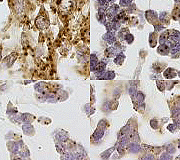
|
Gene Expression Profile of Extraskeletal Myxoid Chondrosarcoma
Subbaya Subramanian,
Robert B. West,
Robert J. Marinelli,
Torsten O. Nielsen,
Brian P. Rubin,
John R. Goldblum,
Rajiv M. Patel,
Shirley Zhu, Kelli Montgomery,
Tony L. Ng,
Christopher L. Corless,
Michael C. Heinrich, and
Matt van de Rijn
|
|
|
|
|
Home
|
-
Welcome to the web
supplement to the paper:
Gene Expression Profile of Extraskeletal Myxoid Chondrosarcoma
published May, 2005 in Journal of Pathology 206. DOI: 10.1002/path.1792
-
Abstract:
Extraskeletal myxoid chondrosarcoma (EMC) is a soft tissue tumor that occurs
primarily in the extremities and is characterized by a balanced translocation
most commonly involving t(9;22) (q22;q12). The morphological spectrum of EMC
is broad and thus a diagnosis based on histology alone can be difficult.
Currently, no systemic therapy exists that improves survival in EMC cases.
We have performed gene expression profiling to discover new diagnostic markers
and potential therapeutic targets. Global gene expression profiling of 10
EMC and 26 other sarcomas using 42,000 spot cDNA microarrays revealed that
the cases of EMC were closely related to each other and distinct from the other
tumors profiled. Significance analysis of microarrays (SAM) identified 86 genes
that distinguished EMC from the other sarcomas with 0.25% likelihood of false
significance. NMB, DKK1, DNER, CLCN3, and DEF6 were the top 5 genes in this
analysis. In situ hybridization for NMB gene expression on tissue microarrays
(TMAs) containing a total of 1,164 specimens representing 62 different sarcoma
types and 15 different carcinoma types showed that NMB was highly expressed in
17 of 22 EMC cases and very rarely expressed in other tumors and thus could
function as a novel diagnostic marker. High levels of expression of PPARG
and its interacting protein PPARGC1A in most EMCs suggest activation of lipid
metabolism pathways in this tumor. Small molecule inhibitors for PPARG exist
and PPARG could be a potential therapeutic target for EMC.
|
|
|
|
[ Home
| Figures and tables
| Images
| Data
| WebPortal
| Authors
]
|
